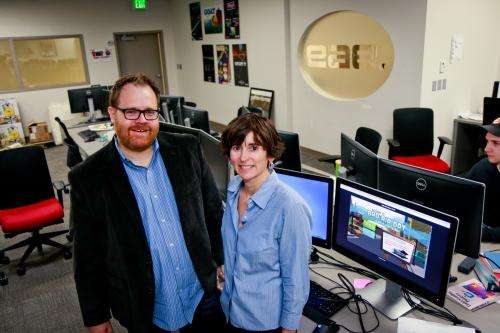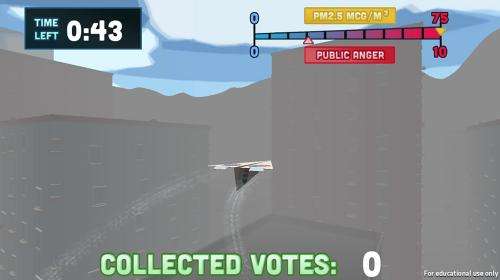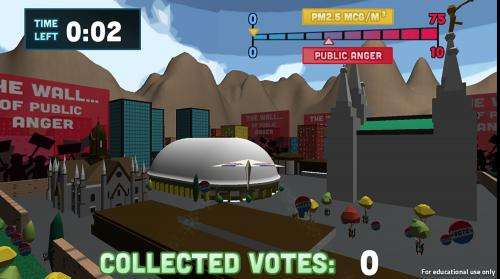Roger Altizer, EAE Director of Therapeutic Games and Apps (The Gapp) Lab at the University of Utah, left, and Kerry Kelly, a U chemical engineering research associate, have produced “Bad Air Day: Play It Like ‘UCAIR,’” a new video game that teaches high school students about what impacts air quality. Kelly, an expert in air quality, came up with the idea for the game and turned to Altizer and the U’s Entertainment Arts and Engineering video game design program to produce it. Credit: Dan Hixson/University of Utah College of Engineering
It's not all fun and games when Utah's Wasatch Front has a bad air day thanks to pollution trapped by a weather inversion. But a new computer game developed at the University of Utah puts thumb-twitching excitement into learning about the science and politics of air quality.
"Bad Air Day: Play It Like 'UCAIR'" is a new web-based game for teens that introduces them to the factors that create the hazy, cough-inducing pollution that plagues the Salt Lake Valley during the winter months. It looks and plays like a 3-D, flying game, but it teaches why Utah's air-pollution woes are local and frequently misunderstood. A University of Utah chemical engineer and a professor from the U's Entertainment Arts and Engineering video game program led the team of developers.
The game creators will unveil and demonstrate "Bad Air Day" at the Air Quality in Utah: Science for Solutions workshop on Tuesday, Jan. 13, at noon. The workshop will be held in the Douglas Ballroom of the University of Utah Guest House and Conference Center, 110 S. Fort Douglas Blvd., in Salt Lake City.
Players can check out the free video game beginning Jan. 13 by going to BadAirDay.org. It is playable on both PCs and Macs and compatible with most web browsers, including Firefox, Chrome, Safari and Internet Explorer.
Players take on the role of mayor and try to collect votes by flying a paper airplane through a 3-D model of Salt Lake City. But before taking off, the player must first decide whether to ban wood fireplaces, promote the use of public transportation, have residents raise home thermostats or take other policy steps to change emission levels. Game play reveals the varying impacts of a range of personal decisions and political actions.
If the player makes decisions that dirty the air, the city will be covered in smog, making it more difficult to fly the plane. If the player makes decisions for cleaner air, it may take away some of our daily conveniences and create a "Wall of Public Anger" that could block the player's ability to collect votes.
U chemical engineering research associate Kerry Kelly, who came up with the idea for the game, wanted high school students and teachers to start thinking critically about air quality.
"I wanted them to learn that air quality is a challenge for the Wasatch Front, that there are real solutions and strategies we can consider and implement to improve air quality but that there are also trade-offs," said Kelly, who also is associate director of the U's Program for Air Quality, Health, and Society. "I'm hoping to inspire them to ask questions about air quality and what causes our poor wintertime air quality."
A screenshot from “Bad Air Day: Play It Like ‘UCAIR,’” a video game produced by the University of Utah that teaches high school students about the science and politics of air pollution along the Wasatch Front.
More than 10 people, including four graduate students, worked on the game for more than five months, said Roger Altizer, director of game design and production for Entertainment Arts and Engineering, an interdisciplinary program in the U's engineering and fine arts colleges.
"We believe that natural learning occurs through play, through experimentation," he said. "Our big goal is for students to play with the information. We believe they will learn more about local air-quality when they have fun exploring it. The air-quality game has a chance to make a real difference in Utah."
EAE students plan to add new features to "Bad Air Day" later this year, and a learning plan for teachers will be produced to accompany the game.
Provided by University of Utah

























